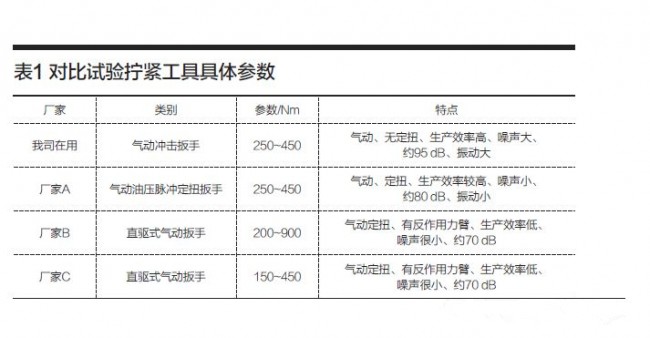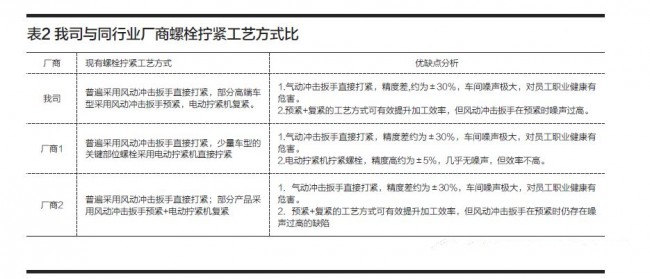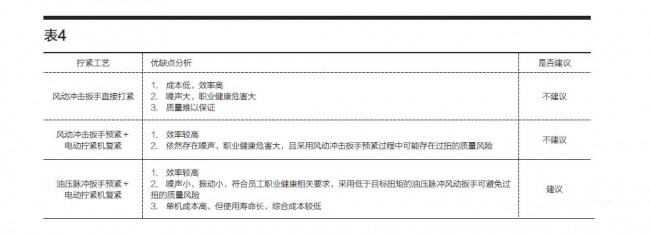1. Bolt tightening basics The purpose of the bolting is to make two or more connected parts fit tightly. In order to withstand a certain moving load, it is necessary to have sufficient clamping force between the connecting pieces to ensure reliable connection and normal operation of the connected parts. The clamping force needs to be converted by applying torque to the bolt, 50% of the applied torque overcomes the friction under the bolt head, 40% overcomes the friction of the thread pair, and the remaining 10% is converted into the clamping force (see Figure 1). Common bolt tightening tools can be divided into three categories based on the power source of the bolt tightening tool, namely pneumatic tightening tools, electric tightening tools and manual tightening tools. 1.1 Principle and characteristics of pneumatic impact tightening tools The pneumatic impact type tightening tool rotates the pneumatic motor mechanism by high-pressure gas to output the rotating force to the striking mechanism, and the striking mechanism drives the striking shaft to form a reciprocating front and rear and a rotating motion, so as to generate a constant torque. Its main features are fast tightening, large torque range, light weight, no reaction force, easy operation and maintenance, large noise, low precision and unstable torque output. 1.2 Principle and characteristics of pneumatic fixed-twist tools 1.2.1 Pneumatic clutch type fixed torque wrench The pneumatic clutch type fixed torque wrench rotates by a high-pressure gas-driven pneumatic motor mechanism, and outputs a rotational force to the striking mechanism. The striking mechanism drives the striking shaft to form a reciprocating front and rear and a rotating motion. When the connected member reaches a preset torque, the clutch The work automatically stops the tightening action. Its main features are: low noise, no shock vibration; automatic shutdown when the preset torque is reached, can automatically control the torque, no risk of over-tightening; self-important, reactionary, suspending operations, strict space requirements; low speed, tightening low efficiency. 1.2.2 Pneumatic oil pressure pulse type torque wrench The pneumatic oil pressure pulse type torsion wrench uses the size of the oil flow to drive the oil and controls the torque output. When the preset torque value is reached, the hydraulic cylinder will continue to pulse without increasing the torque output, thus effectively controlling the torque. Its main features are: easy operation, low noise, low vibration, sustainable use; automatically stop tightening when the preset torque is reached, can automatically control the torque, no risk of over-tightening; no reaction force, no special requirements for the working space; High, high tightening efficiency, the same as the impact wrench; compared with the impact wrench, the product unit price is high, requires professional maintenance and repair, but has a long service life. 1.3 Principle and characteristics of electric fixed twist tools The electric fixed torque tool uses a servo motor as a power unit, connects the speed reduction mechanism, increases the output torque, and then connects the torque sensor to detect the torque. It is possible to accurately control parameters such as output torque, angle, and number of turns. The main features of its work are: almost no noise (65dB); good ergonomics; high precision; suitable for all kinds of connections; small size; torque programmable; data storage; wide torque range (60~4000Nm); Reaction arm. 2, pneumatic tightening tool comparison test Based on the performance of our existing tightening tools, the impact of different pneumatic tightening tools on the bolt tightening process capability, the test station is a station in the frame assembly workshop, the bolt tightening torque requirement of this station For the 280±28Nm, the specific parameters of the tightening tools involved in the comparative test are shown in Table 1. 2.1 Our company is using tools Our company is currently using pneumatic impact wrench, the gear position is 4 gears. The assembly process is judged by the operator according to the experience and feel. When the tightening action is terminated, the tightening torque is controlled near the torque. The test sample volume is 783, normality. The test P value was 0.492 (>0.05), and the data followed a normal distribution with a mean torque of 288.2 Nm and a standard deviation of 33.44. Based on the performance of the existing tools, the target value, specification upper limit, and lower specification limit in the subsequent comparative analysis process were determined to be 288.2 Nm, 388.52 Nm, and 187.88 Nm, respectively. 2.2 Manufacturer A Pneumatic Oil Pressure Pulse Torque Wrench The manufacturer A pneumatic oil pressure pulse torsion wrench is a pressure relief type torsion tool. The standard pressure relief torque is 280Nm. During the use, the operator stops tightening only after the wrench is automatically relieved of pressure. There is no personnel intervention or correction during the tightening process, and the tightening result is determined by the tool. The number of test samples was 293, with an average of 322.3 Nm, a standard deviation of 39.3, a process capability index of Cp=0.98, and a Cpk of 0.64. The displayed torque average is too large and can be solved by recalibration; however, the standard deviation is too large, so that the Cp value is <1, and the overall performance is not as good as that of the skilled worker using a common pneumatic impact wrench. 2.3 Manufacturer B direct drive pneumatic wrench The manufacturer B direct-drive pneumatic wrench is a gas-breaking fixed-torque tool, and the rated relief torque is 280 Nm in the standard environment. The number of test samples is 156, the average value is 327.5Nm, the standard deviation is 29, and the process capability refers to The number Cp = 1.6 and Cpk = 0.97. Similarly, the torque average can be recalibrated to approach the target value. There is no human intervention in the tightening process. The final result is determined by the tool. The assembly process capability index can reach 1.6 times that of the existing tool, which is much higher than the existing control level. 2.4 manufacturers C direct drive pneumatic wrench The manufacturer C direct drive pneumatic wrench is a gas-breaking fixed-torque tool. The standard unloading torque is 280Nm under standard environment. It can convert the torque value into electric signal. After the operation, it shows the torque value and has certain communication function. Pressure requirements are not critical and only require air supply. Test sample 58 Vehicle, analysis results: mean 290.7Nm, standard deviation: 15.9, Cp = 2.37, Cpk = 2.31. In summary, 1. Manufacturer A pneumatic oil pressure pulse wrench has poor torsion accuracy, and the actual performance is not as good as that of skilled workers using ordinary pneumatic impact wrenches; 2. The manufacturer B direct drive pneumatic wrench has a good torsion accuracy. After recalibration, its performance can reach 1.6 times that of the existing tools; 3. The manufacturer C direct drive pneumatic wrench has the best performance, which is better than the manufacturer's two direct drive pneumatic wrench. Through the on-site experimental test of pneumatic impact wrench, pneumatic hydraulic pulse wrench and pneumatic fixed-torque direct-drive wrench, the bolt tightening torque can not be guaranteed by the experience of the staff. It must be guaranteed by the fixed-torque tool. The accuracy of the direct-drive pneumatic wrench studied above is accurate. High, but all have low speed and production efficiency The rate is low, affecting the shortcomings of the existing production tempo, and only one or two kinds of fixed torque can be preset, which can not meet the requirements of bolt torque of different specifications of our frame. 3, the benchmark of the bolt tightening process of the same manufacturer The investigation of the bolt tightening process of the top two heavy truck manufacturers in the domestic industry was conducted and compared with our company (Table 2). 4. Bolt tightening process plan recommended for our company At present, our company generally uses pneumatic impact wrenches to directly tighten the bolts. Some high-end models are pre-tightened with pneumatic impact wrenches and the electric tightening machine is tightened. With the increasing emphasis on the occupational health of employees, the workshop Noise reduction has become a new topic that the craftsman is trying to solve. In order to eliminate or reduce the noise generated by the pneumatic impact wrench, the craftsman proposed whether a small torque hydraulic pulse wrench can be used instead of the traditional pneumatic impact wrench to achieve noise reduction. The advantages and disadvantages are shown in Table 3. Based on the above comparison, considering the factors of cost, quality, efficiency, occupational health, etc., the three kinds of tightening process analysis are shown in Table 4. Editor in charge: Hu Na
Wire Mesh widely used for industries of mining, oil, chemicals, food, pharmaceuticals, scientific research, aviation, etc.
the mesh products are designed to be used in a variety of applications, providing safety protection and access control to everything from military bases to electrode. Constructed from high durable steel with a cold-rolled finish, they are easily installed in your commercial or industrial enterprise. Wire Mesh Stainless Wire Mesh,Wire Mesh,Plain Weave Wire Mesh,150 Micron Filter Mesh Xinxiang Xin Ming De Machinery Co., Ltd. , https://www.xmdsieve.com




Stainless steel mesh have features of good filtering, acid-resistant, alkali-resistant, corrosion-resistant, heat-resistant .